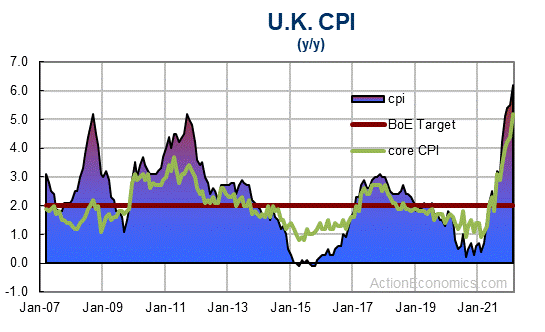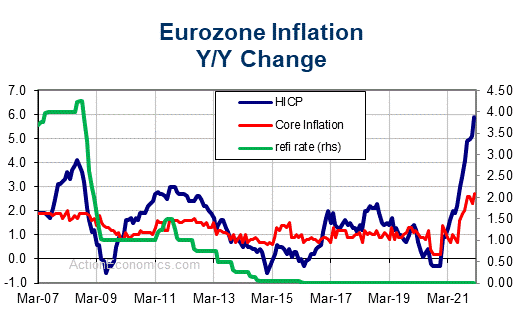Bunds and other Eurozone bond markets remain under pressure as stronger than expected German orders at the start of the session add to the arguments for a change of course in March, which judging by Lagarde’s comments clearly is on the agenda next months, when the updated set of staff projections are also available. Stock markets have recovered though, after being pressured by hawkish central banks in Europe and disappointing reports form tech giants yesterday. The Euro has remained supported, after jumping on the ECB’s hawkish turn yesterday and EURUSD is at 1.1475 and EURGBP at 0.8465, amid wider weakness in Sterling, as markets contemplate the impact of the multiple rate hikes, the BoE flagged yesterday.
BoE and ECB both seemed spooked by the spike in inflation today, highlighting that the focus has well and truly shifted, and virus concerns are no longer the centre of attention. The BoE not just delivered another hike, but sent a pretty clear signal that more is to come and while the initial ECB statement sounded surprisingly dovish, Lagarde’s presser signalled a hawkish shift that sets the ECB up for a rate hike later in the year, and maybe even an earlier end to net asset purchases than it seemed committed to at the last meeting. The actual decision was postponed to the March meeting though and in any case, the ECB’s policy stance is still set to remain considerably more expansionary than those of BoE and Fed.
The BoE delivered the expected 25 bp rate hike today and lifted Bank Rate to 0.50%, but the real surprise was the voting pattern, as four out of the nine MPC members actually opted for a 50 bp hike. So rather than reflecting some cautious voices in the discussion over the first back to back hike since 2004, the vote highlighted urgency on the need to address inflation overshoots, that risk getting out of hand. Remaining uncertainty on the outlook prevented the majority from going for an even bolder move, but the statement said “some further modest tightening is likely to be appropriate in the coming months“, which makes clear that more is to come.
On top of this, QE tightening is underway. The BoE will immediately stop the reinvestment of expired Gilts purchased under the programs, which will allow more than £200 bln to run off by 2025. It also announced plans to offload the entire £20 bln stock of corporate bonds by the end of next year. BoE officials lifted their forecast for the peak of inflation to 7.25% from 6% expected at the time of the last set of forecasts in November 2021. The updated monetary policy report also highlighted that the labour market remains very tight and projections for wage growth are see the underlying pace hitting 4.75% in the coming year. Higher energy prices remain the main driving factor for the spike in prices and the expected jump in the cost of living, which will likely slow GDP growth.

Central bank calculations suggest that by the November of last year the economy was back to the size before Covid hit and while the economy is still expected to growth over the next few years, beyond the immediate bounce back from Omicron, reduced spending power will limit the medium term growth outlook. Unemployment is expected to lift to 5% from around 4% currently and lead to increased slack in the economy by the end of the forecast period. Inflation is expected to be a little above the central bank’s target in two years time and drop below that in three years, based on the market projections for interest rates that currently imply that interest rates will hit 1.5% by the middle of next year.
That would imply the market path may be slightly too pessimistic on the rate outlook. Indeed, the BoE’s projection show that an alternative scenario based on energy prices following their futures curve, rather than remaining constant after 6 months, would lead to inflation dropping to around 0.75 points below target in two and three year’s time. So while the BoE may be set on hiking rates again in coming months, rate hikes further out may be less aggressive than markets predicted before today’s move. With that in mind today’s reaction to the statement looks somewhat overblown.

Over in Frankfurt meanwhile the ECB’s initial statement was little changed from December, but Lagarde’s presser very much flagged a hawkish turn at the central bank. Lagarde stressed that all council members were concerned by recent inflation overshoots and the possible risks to the medium term outlook for price stability. There is growing confidence that the economy will bounce back quickly from Omicron and Lagarde said output reached pre-pandemic levels at the end of last year. Against that background, the ECB President flagged the risk that inflation will remain higher for longer than previously expected.
As in the UK energy price increases remain the main drivers of inflation, but Lagarde also admitted that measures of underlying inflation have lifted, even though she still said the persistence of underlying inflation remains uncertain. Nevertheless, with labour market conditions improving further wages are likely to pick up going forward. While the risks to the growth outlook are judged to be broadly balanced, the risks to the inflation outlook is now tilted to the upside.
New projections will become available with the updated set of forecasts in March and Lagarde very strongly hinted that the next meeting will bring a new roadmap for the path to policy normalisation. She directly pointed to the March meeting and the new projections that would allow a more meaningful decision. So a hike in the second half of the year is not ruled out.
Lagarde was very clear that the sequence on policy normalisation still holds, so net asset purchases are still set to end shortly before the first rate hike. Net purchases under PEPP will end in March, but today’s statement still repeated that “monthly net purchases under the APP will amount to €40 billion in the second quarter of 2022 and €30 billion in the third quarter“, which sounds as though net purchases would continue at least through the second quarter. Beyond that the statement continued to say that “from October onwards, the Governing Council will maintain net asset purchases under the APP at a monthly pace of €20 billion for as long as necessary to reinforce the accommodative impact of its policy rates.”
If the ECB stands by that it could end net purchases early in Q4 and deliver a rate hike at the end of the year, but quizzed on the point of net asset purchases Lagarde seemed to leave the door open to an adjustment in the net asset purchase schedule in March. That could set the Eurozone up for an even earlier rate hike and with Lagarde stressing the importance of both the March and the June meetings, it seems to bring a move as early as September into play.
Click here to access our Economic Calendar
Andria Pichidi
Market Analyst
Disclaimer: This material is provided as a general marketing communication for information purposes only and does not constitute an independent investment research. Nothing in this communication contains, or should be considered as containing, an investment advice or an investment recommendation or a solicitation for the purpose of buying or selling of any financial instrument. All information provided is gathered from reputable sources and any information containing an indication of past performance is not a guarantee or reliable indicator of future performance. Users acknowledge that any investment in Leveraged Products is characterized by a certain degree of uncertainty and that any investment of this nature involves a high level of risk for which the users are solely responsible and liable. We assume no liability for any loss arising from any investment made based on the information provided in this communication. This communication must not be reproduced or further distribution.



















